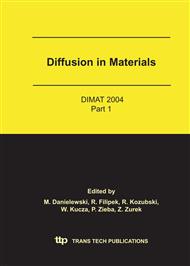p.1252
p.1258
p.1264
p.1270
p.1275
p.1281
p.1287
p.1293
p.1299
Simulation of Interstitial Atom Diffusion in FCC Metals with Point Defects
Abstract:
This work is devoted to simulation of interstitial atom diffusion in fcc metals with point defects. We used the molecular static and the Monte Carlo methods. An activation barrier set for different configurations of the carbon–vacancy complexes is simulated by the method of the molecular static (MS). Then we calculate atom jump rates for these configurations. The simulation of the carbon and vacancy migration in an fcc metal is realized on the basis of obtained atom jump rates by using the Monte-Carlo (MC) method. In particular, the calculations were made for the system of the nickel-carbon. In the result of that interstitial atom diffusion coefficient has been obtained at different temperatures.
Info:
Periodical:
Pages:
1275-1280
Citation:
Online since:
April 2005
Authors:
Keywords:
Price:
Сopyright:
© 2005 Trans Tech Publications Ltd. All Rights Reserved
Share:
Citation:


